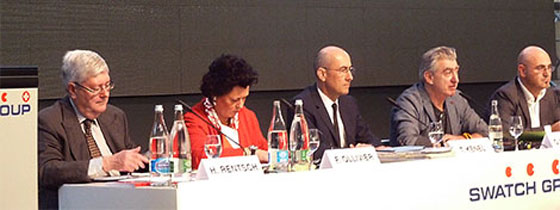
The traditional Swatch Group press conference was held on 12 March. Presentation of the 2014 figures, the prospects for 2015 and of course connected watches: those were the subjects which captured the audience’s attention.
Each year the Swatch Group invites the press to visit one of its entities. This is an opportunity to comment on the previous year’s figures, present the prospects for the next twelve months and enable visitors to discover the different production facilities. Last March the rendez-vous was arranged at Swiss Timing, in Corgémont.
Nick Hayek opened the conference by reassuring the audience: the group is doing very well despite the exchange rate effects which remain unfavourable and the announcements made by the Swiss National Bank. In the first two months of this year growth has been very strong and 2015 is looking particularly good. He had already set the tone.
But back now to 2014. As forecast, the group’s gross sales figures passed the 9 billion francs mark, a rise of 4.6%. On the other hand, the net profit was down – for the first time since 2009 – at 1.42 billion (-26.6%). The operating profit stood at 1.75 billion against 2.31 in the previous year. Last year the group created 2,100 new jobs including 770 in Switzerland. It invested some 558 million in its production facilities, including the new Universo entity at La Chaux-de-Fonds, which is also home to the dial manufacturer Rubattel & Weyermann. A further 390 million went on new equipment, including a white room at Nivarox-FAR. The group also acquired a magnificent historic edifice on the Bahnhofstrasse in Zurich, the Grieder House (at a cost of around 150 million). The fire which broke out in an electroplating workshop at ETA in Granges impaired the 2014 results by 200 million francs.
Keenly awaited at this press conference, the subject of smart watches fascinated the audience. The first question to ask is this: what do we expect a smartwatch to do? Must it necessarily resemble a mobile phone? The Swatch Group does not think so and presented two models of connected watches which will shortly be launched on the market. First, the Swatch Touch Zero One, a version of the Swatch Touch introduced four years ago. This model will be dedicated to the world of beach volley, for players and fans alike. It offers functions such as counting the number of steps or calories expended, the force of a smash, the function of virtual coach and for fans the intensity of applause. The heart of this watch is a chip working with NFC (Near Field Communication) technology which will enable the user to do many things, e.g. buy an ice cream or a cinema seat. This turns the watch into a “tool” enabling purchases to be paid for at any store equipped with an NFC reader. Other versions of the Swatch Touch Zero are planned. The Zero Two will be destined for the world of extreme ski and the Zero Three for wind surfing while the Zero Four will be launched in time for the Olympic Games at Rio in the summer of 2016. In other words the future for this watch looks promising! Nick Hayek argued against the idea of turning the smart watch into a small-scale version of a mobile phone worn on the wrist. The group wants to give consumers new technologies with a long power reserve unlike the products currently available on the market which have to be charged up at regular intervals.
Another connected watch on display was the Gent again featuring an electronic chip using NFC technology. The Gent model was chosen as an example but all these watches, preferably made of plastic materials or resistant to magnetic fields can incorporate this technology. In the near future, we will therefore be able to carry a purse on our wrist as this timepiece enables purchases to be paid for directly using NFC system. In the same spirit, Nick Hayek announced a new partnership with China Unionpay, a Chinese credit company with 165 members in Asia and 200 more elsewhere in the world. Knowing the purchasing power of the Asian world, the potential of a watch of this kind is abundantly clear!
At the head of all these electronic developments, the EM Microelectronic company of Marin, a group subsidiary. When it was created in 1975 this enterprise worked essentially for the watchmaking industry. Today that particular field represents no more than 10% of its activities. EM Electronic distributes its electronic systems all over the world. Among other activities, it is the sole supplier of circuits for credit cards in Europe. This group entity has developed what is known as passive NFC technology. The term passive is used because the chip fitted in these watches requires no energy. The necessary energy is provided by the data readers themselves. Readers of this kind are being used on an increasingly wide scale all over the world so guaranteeing the success of this system.
A word now about the host of the day’s meeting, Swiss Timing. Alain Zobrist, its chief executive officer, painted a quick portrait of his firm. Swiss Timing is responsible for all the group’s timekeeping activities including Omega (Olympic Games, athletics) and Longines (FIS ski competitions, equestrian events) and so on. The company not only takes care of timekeeping but continuously develops new devices designed to measure thousandths of a second. It also sells its know-how worldwide. 170 staff members work here every day with 200 others in subsidiaries located in Germany and in the Czech Republic. In 2015 Swiss Timing will be responsible for timekeeping at over 500 competitions.
March 26, 2015


 News
News